General Properties of Living Systems
The most outstanding general features that have arisen during life's history include chemical uniqueness; complexity and hierarchical organization; reproduction (heredity and variation); possession of a genetic program; metabolism; development; and environmental interaction.
- Chemical uniqueness.
Living systems demonstrate a unique and complex molecular organization. The history of life has featured the assembly of large molecules, known as macromolecules, that are far more complex than the small molecules that constitute nonliving matter. These macromolecules are composed of the same kinds of atoms and chemical bonds that occur in nonliving matter and they obey all fundamental laws of chemistry; it is only the complex organizational structure of these macromolecules that makes them unique. We recognize four major categories of biological macromolecules: nucleic acids, proteins, carbohydrates, and lipids (see The Origin and Chemistry of Life). These categories differ in the structures of their component parts, the kinds of chemical bonds that link their subunits together, and their functions in living systems.
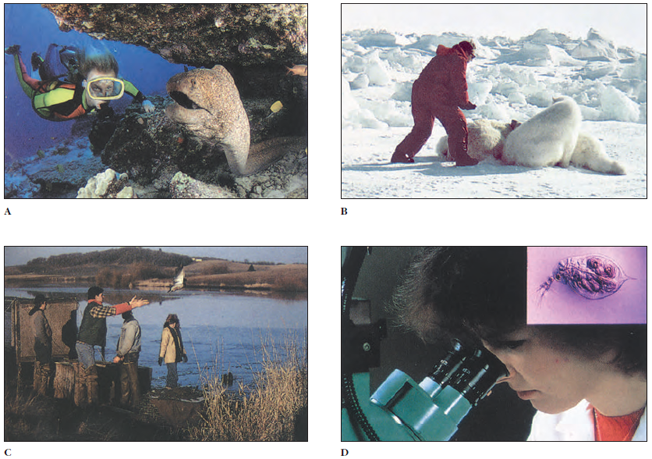
Figure 1-1 A few of the many dimensions of zoological research: A, Observing moray eels in Maui, Hawaii; B, Working with tranquilized polar bears; C, Banding mallard ducks; D, observing Daphnia pulex (×150) microscopically.
The general structures of these macromolecules evolved and stabilized early in the history of life. With some modifications, these same general structures are found in every form of life that we observe today. Proteins, for example, contain about 20 specific kinds of amino acid subunits linked together by peptide bonds in a linear sequence (Figure 1-2). Additional bonds occurring between amino acids that are not adjacent to each other in the protein chain give the protein a complex, three-dimensional structure (see Figures 1-2 and 2-11). A typical protein contains several hundred amino acid subunits. Despite the stability of this basic protein structure, the ordering of the different amino acids in the protein molecule is subject to enormous variation. This variation underlies much of the diversity that we observe among different kinds of living forms. The nucleic acids, carbohydrates, and lipids likewise contain characteristic bonds that link variable subunits (The Origin and Chemistry of Life). This organization gives living systems both a biochemical unity and a great potential for diversity.
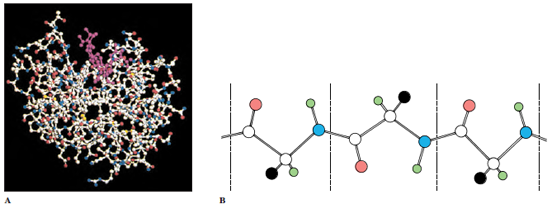
Figure 1-2 A computer simulation of the three-dimensional structure of the lysozyme protein (A), which is used by animals to destroy bacteria. The protein is a linear string of molecular subunits called amino acids, connected as shown in B, that fold in a three-dimensional pattern to form the active protein. The white balls correspond to carbon atoms, the red balls to oxygen, the blue balls to nitrogen, the yellow balls to sulfur, the green balls to hydrogen, and the black balls (B) to molecular groups formed by various combinations of carbon, oxygen, nitrogen, hydrogen, and sulfur atoms that differ among amino acids. Hydrogen atoms are not shown in A. The purple molecule in A is a structure from the bacterial cell wall that is broken by lysozyme. -
Complexity and hierarchical organization.
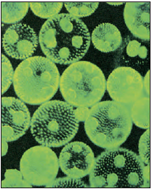
Figure 1-3 Volvox globator (see pp.
224–225) is a multicellular
phytoflagellate that illustrates three different
levels of the biological hierarchy: cellular,
organismal, and populational. Each
individual spheroid (organism) contains cells
embedded in a gelatinous matrix. The larger cells
function in reproduction, and the smaller ones
perform the general metabolic functions of
the organism. The individual spheroids
together form a population.
Living systems demonstrate a unique and complex hierarchical organization. Nonliving matter is organized at least into atoms and molecules and often has a higher degree of organization as well. However, atoms and molecules are combined into patterns in the living world that do not exist in the nonliving world. In living systems, we find a hierarchy of levels that includes, in ascending order of complexity, macromolecules, cells, organisms, populations, and species (Figure 1-3). Each level builds on the level below it and has its own internal structure, which is also often hierarchical. Within the cell, for example, macromolecules are compounded into structures such as ribosomes, chromosomes, and membranes, and these are likewise combined in various ways to form even more complex subcellular structures called organelles, such as mitochondria (see Cells as Units of Life and Cellular Metabolism). The organismal level also has a hierarchical substructure; cells are combined into tissues, which are combined into organs, which likewise are combined into organ systems (see Architectural Pattern of an Animal).
Cells (Figure 1-4) are the smallest units of the biological hierarchy that are semiautonomous in their ability to conduct basic functions, including reproduction. Replication of molecules and subcellular components occurs only within a cellular context, not independently. Cells are therefore viewed as the basic units of living systems (Cells as Units of Life). We can isolate cells from an organism and cause them to grow and multiply under laboratory conditions in the presence of nutrients alone. This semiautonomous replication is not possible for any individual molecules or subcellular components, which require additional cellular constituents for their reproduction. Each successively higher level of the biological hierarchy is composed of units of the preceding lower level in the hierarchy. An important characteristic of this hierarchy is that the properties of any given level cannot be obtained from even the most complete knowledge of the properties of its component parts. A physiological feature, such as blood pressure, is a property of the organismal level; it is impossible to predict someone's blood pressure simply by knowing the physical characteristics of individual cells of the body. Likewise, systems of social interaction, as observed in bees, occur at the populational level; it would not be possible to infer properties of this social system by knowing only properties of individual bees.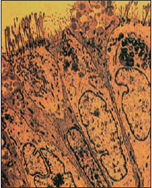
Figure 1-4 Electron
micrograph of ciliated
epithelial cells and
mucus-secreting cells
(see pp. 185–188).
Cells are the basic
building blocks of living
organisms.
The appearance of new characteristics at a given level of organization is called emergence, and these characteristics are known as emergent properties. These properties arise from interactions that occur among the component parts of a system. For this reason, we must study all levels directly, and subdivisions of the field of biology (molecular biology; cell biology; organismal anatomy, physiology and genetics; population biology) reflect this fact (Table 1-1). We find that emergent properties expressed at a particular level of the biological hierarchy are certainly influenced and restricted by properties of the lower-level components. For example, it would be impossible for a population of organisms that lack hearing to develop a spoken language. Nonetheless, properties of parts of a living system do not rigidly determine the properties of the whole. Many different spoken languages have emerged in human culture from the same basic anatomical structures that permit hearing and speech. The freedom of the parts to interact in different ways makes possible a great diversity of potential emergent properties at each level of the biological hierarchy.
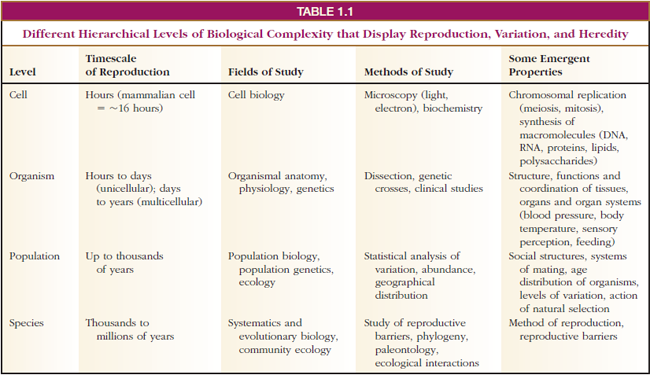
Different levels of the biological hierarchy and their particular emergent properties are products of evolution. Before multicellular organisms evolved, there was no distinction between the organismal and cellular levels, and it is still absent from single-celled organisms (Protozoan Groups). The diversity of emergent properties that we see at all levels of the biological hierarchy contributes to the difficulty of giving life a simple definition or description.
- Reproduction.
Living systems can reproduce themselves. Life does not arise spontaneously but comes only from prior life, through a process of reproduction. Although life certainly originated from nonliving matter at least once (The Origin and Chemistry of Life), this required enormously long periods of time and conditions very different from those of the modern biosphere. At each level of the biological hierarchy, living forms reproduce to generate others like themselves (Figure 1-5). Genes are replicated to produce new genes. Cells divide to produce new cells. Organisms reproduce, sexually or asexually, to produce new organisms (Principles of Genetics:A Review). Populations can become fragmented to give rise to new populations, and species can give rise to new species through a process known as speciation. Reproduction at any level of the hierarchy usually features an increase in numbers. Individual genes, cells, organisms, populations, or species may fail to reproduce themselves, but reproduction is nonetheless an expected property of these individuals.
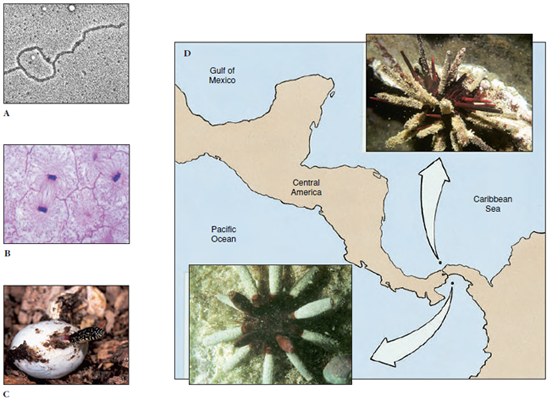
Figure 1-5 Reproductive processes observed at four different levels of biological complexity: A, Molecular level—electron micrograph of a replicating DNA molecule; B, Cellular level—micrograph of cell division at mitotic telophase; C, Organismal level—a king snake hatching; D, Species level—formation of new species in the sea urchin (Eucidaris) after geographic separation of Caribbean (E. tribuloides) and Pacific (E. thouarsi) populations by the formation of a land bridge.
Reproduction at each of these levels features the complementary, and yet apparently contradictory, phenomena of heredity and variation. Heredity is the faithful transmission of traits from parents to offspring, usually (but not necessarily) observed at the organismal level. Variation is the production of differences among the traits of different individuals. In the reproductive process, the properties of descendants resemble those of their parents to varying degrees but are usually not identical to them. Replication of deoxyribonucleic acid (DNA) occurs with high fidelity, but errors occur at repeatable rates. Cell division is an exceptionally precise process, especially with regard to the nuclear material, but chromosomal changes occur nonetheless at measurable rates. Organismal reproduction likewise demonstrates both heredity and variation, the latter being obvious especially in sexually reproducing forms. The production of new populations and species also demonstrates conservation of some properties and changes of others. Two closely related frog species may have similar mating calls but differ in the rhythm of repeated sounds.
We will see later in sections that the interaction of heredity and variation in the reproductive process is the basis for organic evolution (Organic Evolution). If heredity were perfect, living systems would never change; if variation were uncontrolled by heredity, biological systems would lack the stability that allows them to persist through time.
- Possession of a genetic program.
A genetic program provides fidelity of inheritance (Figure 1-6). The structures of the protein molecules needed for organismal development and functioning are encoded in nucleic acids (Principles of Genetics:A Review). For animals and most other organisms, the genetic information is contained in DNA. DNA is a very long, linear chain of subunits called nucleotides, each of which contains a sugar phosphate (deoxyribose phosphate) and one of four nitrogenous bases (adenine, cytosine, guanine, or thymine, abbreviated A, C, G, and T, respectively). The sequence of nucleotide bases represents a code for the order of amino acids in the protein specified by the DNA molecule. The correspondence between the sequence of bases in DNA and the sequence of amino acids in a protein is known as the genetic code.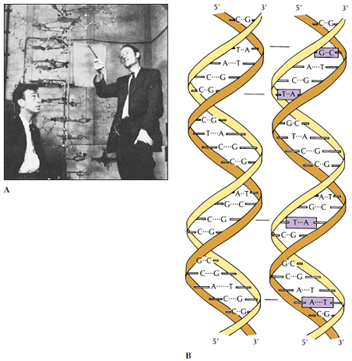
Figure 1-6 James Watson and Francis Crick with a model
of the DNA double helix (A). Genetic information is
coded in the nucleotide base sequence inside the DNA
molecule. Genetic variation is shown (B) in DNA
molecules that are similar in base sequence but differ from
each other at four positions. Such differences can encode
alternative traits, such as different eye colors.
The genetic code was established early in the evolutionary history of life, and the same code is present in bacteria and in the nuclear genomes of almost all animals and plants. The near constancy of this code among living forms provides strong evidence for a single origin of life. The genetic code has undergone very little evolutionary change since its origin because an alteration would disrupt the structure of nearly every protein, which would in turn severely disrupt cellular functions that require very specific protein structures. Only in the rare instance in which the altered protein structures are still compatible with their cellular functions would such a change have a chance to survive and be reproduced. Evolutionary change in the genetic code has occurred in the DNA contained in animal mitochondria, the organelles that regulate cellular energy. The genetic code in animal mitochondrial DNA therefore is slightly different from the standard code of nuclear and bacterial DNA. Because mitochondrial DNA specifies far fewer proteins than nuclear DNA, the likelihood of getting a change in the code that does not disrupt cellular functions is greater there than in the nucleus.
- Metabolism.
Living organisms maintain themselves by obtaining nutrients from their environments (Figure 1-7). The nutrients are broken down to obtain chemical energy and molecular components for use in building and maintaining the living system (Cellular Metabolism). We call these essential chemical processes metabolism. They include digestion, production of energy (respiration), and synthesis of molecules and structures. Metabolism is often viewed as an interaction of destructive (catabolic) and constructive (anabolic) reactions. The most fundamental anabolic and catabolic chemical processes used by living systems arose early in the evolutionary history of life and are shared by all living forms. These include synthesis of carbohydrates, lipids, nucleic acids, and proteins and their constituent parts and the cleavage of chemical bonds to recover energy stored in them. In animals, many fundamental metabolic reactions occur at the cellular level, often in specific organelles that are found throughout the animal kingdom. Cellular respiration occurs, for example, in the mitochondria. The cellular and nuclear membranes regulate metabolism by controlling the movement of molecules across the cellular and nuclear boundaries, respectively. The study of the performance of complex metabolic functions is known as physiology. We will devote a large portion of preceding sections in describing and comparing the diverse tissues, organs, and organ systems that different groups of animals have evolved to perform the basic physiological functions of life .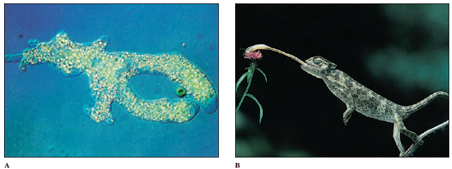
Figure 1-7 Feeding processes illustrated by (A) an ameba surrounding
food and (B) a chameleon capturing insect prey with its projectile tongue.
- Development.
All organisms pass through a characteristic life cycle.Development describes the characteristic changes that an organism undergoes from its origin (usually the fertilization of the egg by sperm) to its final adult form (Principles of Development). Development usually features changes in size and shape, and the differentiation of structures within the organism. Even the simplest one-celled organisms grow in size and replicate their component parts until they divide into two or more cells. Multicellular organisms undergo more dramatic changes during their lives. In some multicellular forms, different stages of their life cycle are so dissimilar that they are hardly recognizable as part of the same species. Embryos are distinctly different from juvenile and adult forms into which they will develop. Even the postembryonic development of some organisms includes stages that are dramatically different from each other. The transformation that occurs from one stage to another is called metamorphosis. There is little resemblance, for example, among the egg, larval, pupal, and adult stages of metamorphic insects (Figure 1-8). Among animals, the early stages of development are often more similar among organisms of related species than are later developmental stages. In our survey of animal diversity, we will describe all stages of observed life histories, but we will concentrate on adult stages in which diversity both within and between different animal groups tends to be greatest.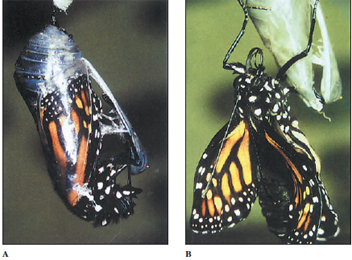
Figure 1-8 Pupal and adult stages of an insect life cycle: A,
Adult monarch butterfly emerging from its pupal case; B,
Fully formed adult monarch butterfly.
- Environmental interaction.
All animals interact with their environments. The study of organismal interaction with the environment is known as ecology. Of special interest are the factors that affect the geographic distribution and abundance of animals (See: The Biosphere and Animal Distribution and Animal Ecology ). The science of ecology permits us to understand how an organism can perceive environmental stimuli and respond in appropriate ways by adjusting its metabolism and physiology (Figure 1-9). All organisms respond to stimuli in their environment, and this property is called irritability. The stimulus and response may be simple, such as a unicellular organism moving from or toward a light source or away from a noxious substance, or it may be quite complex, such as a bird responding to a complicated series of signals in a mating ritual (see Animal Behavior). Life and the environment are inseparable. We cannot isolate the evolutionary history of a lineage of organisms from the environments in which it occurred.

Figure 1-9 A lizard regulates its body temperature by choosing different locations (microhabitats) at different times of day.




